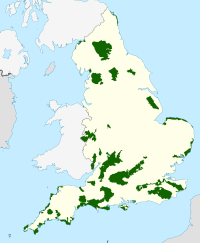Quantock Hills
| Quantock Hills | |
|---|---|
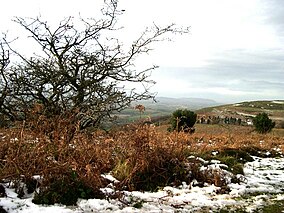 Upland scrub in the Quantocks | |
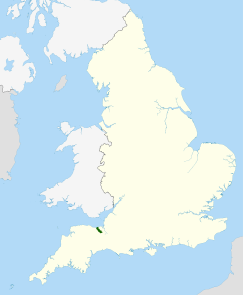 Location of the Quantock Hills AONB in the UK | |
| Location | Somerset, England |
| Coordinates | 51°08′39″N 3°13′59″W / 51.14417°N 3.23306°W |
| Area | 38 sq mi (98 km2) |
| Governing body | Quantock Hills AONB |
| Website | Quantock Hills AONB |
The Quantock Hills west of Bridgwater in Somerset, England, consist of heathland, oak woodlands, ancient parklands and agricultural land. They were England's first Area of Outstanding Natural Beauty, designated in 1956.[1]
The hills run from the Vale of Taunton Deane in the south, for about 15 miles (24 km) to the north-west, ending at Kilve and West Quantoxhead on the coast of the Bristol Channel. They form the western border of Sedgemoor and the Somerset Levels. From the top of the hills on a clear day, it is possible to see Glastonbury Tor and the Mendips to the east, Wales as far as the Gower Peninsula to the north, the Brendon Hills and Exmoor to the west, and the Blackdown Hills to the south. The highest point on the Quantocks is Wills Neck, at 1,261 feet (384 m).[3] Soil types and weather combine to support the hills' plants and animals. In 1970, an area of 6,194.5 acres (2,506.8 ha) was designated as a Biological Site of Special Scientific Interest.[4]
Archaeological landscape features include Bronze Age round barrows, extensive ancient field systems and Iron Age hill forts. Roman silver coins have been discovered in West Bagborough. The hills are popular with walkers, mountain bikers, horse riders and tourists who explore paths such as the Coleridge Way.
Etymology
The name first appears in Saxon charters in around AD 880 as Cantuctun and two centuries later in the Domesday Book as Cantoctona and Cantetone. The name means settlement by a rim or circle of hills;[5] Cantuc is Celtic for a rim or circle, and -ton or -tun is Old English for a settlement. The highest point of the hills is called Will's Neck meaning ridge of the Welshman, probably referring to a time when the hills marked the boundary between the expanding Saxon kingdom of Wessex and the lands of the Britons or 'Welsh' to the West. A battle was fought locally at that time.[3]
Geology

The Quantock Hills are largely formed by rocks of the
Further south there are newer Middle and Late Devonian rocks, known as
Several areas have outcrops of slates. Younger rocks of the
Kilve has the remains of a red-brick retort built in 1924 after the shale in the cliffs was found to be rich in oil. Along this coast, the cliffs are layered with compressed strata of oil-bearing shale and blue, yellow and brown Lias embedded with fossils. The Shaline Company was founded in 1924 to exploit these strata but was unable to raise sufficient capital. The company's retort house is thought to be the first structure erected here for the conversion of shale to oil and is all that remains of the anticipated Somerset oil boom.[9]
At Blue Anchor the coloured alabaster found in the cliffs gave rise to the name of the colour "Watchet Blue".[3] The village has the only updraught brick kiln known to have survived in Somerset. It was built around 1830 and was supplied by small vessels carrying limestone to the small landing jetty.[10] Now used as a garage, the kiln is thought to have operated until the 1870s, when the large-scale production of bricks in Bridgwater rendered small brickyards uneconomic.[11]
Cockercombe tuff is a greenish-grey, hard pyroclastic rock formed by the compression of volcanic ash and is found almost exclusively in the south-eastern end of the Quantock Hills.
Climate

Along with the rest of
Cloud often forms inland especially near hills, and acts to reduce sunshine. The average annual sunshine totals around 1,600 hours. Rainfall tends to be associated with Atlantic depressions or with convection. In summer, convection caused by solar surface heating sometimes forms shower clouds, and a large proportion of rain falls from showers and thunderstorms at this time of year. Average rainfall is around 31 to 35 inches (790 to 890 mm). About 8 to 15 days of snowfall is typical. From November to March, mean wind speeds are highest; winds are lightest from June to August. The predominant wind direction is from the south-west.[12]
Ecology
In 1970 an area of 6,194.5 acres (2,506.8 ha) in the Quantocks was designated as a Biological Site of Special Scientific Interest (SSSI).[4] This a conservation designation denoting a protected area in the United Kingdom, selected by Natural England, for areas with particular landscape and ecological characteristics. It provides some protection from development, from other damage, and (since 2000) also from neglect, under the Countryside and Rights of Way Act 2000.
The streams and open water such as Hawkridge Reservoir and Ashford Reservoir on Cannington Brook also provide habitats for a range of species.
Flora

The hilltops are covered in heathland of gorse, heather, bracken and thorn with plantations of conifer. The western side of the Quantocks are steep
Fauna
The various habitats, together with the wide range of slopes and aspects, provide ideal conditions
for a rich fauna. Amphibians including the palmate newt (Triturus helveticus), common frog (Rana temporaris), and common toad (Bufo bufo) are represented in the damper environments. Reptiles
present include adder (
History
Origins
Evidence of activity in the Quantocks from prehistoric times includes finds of

Little evidence exists of Roman influence on the Quantock region beyond isolated finds and hints of transient forts. A Roman port was at Combwich, and it is possible that a Roman road ran from there to the Quantocks, because the names Nether Stowey and Over Stowey come from the Old English stan wey, meaning stone way.[3] In October 2001 the West Bagborough Hoard of 4th-century Roman silver was discovered in West Bagborough. The 681 coins included two denarii from the early 2nd century, and eight miliarense and 671 siliqua dating to 337–367 AD. The majority were struck in the reigns of emperors Constantius II and Julian and derive from a range of mints including Arles and Lyons in France, Trier in Germany and Rome.[16]
Dark Ages and Anglo-Saxon
The area remained under Romano-British Celtic control until 681–685 AD, when Centwine of Wessex pushed west from the River Parrett, conquered the Welsh King Cadwaladr, and occupied the rest of Somerset north to the Bristol Channel.[17] Saxon rule was later consolidated under King Ine, who established a fort at Taunton in about 700 AD.[18]
The first documentary evidence of the village of
Medieval
After the
Modern
There was very little action on the Quantocks during the
At the end of the

In 1724 the 14th century spire of the Church of the Holy Ghost in Crowcombe was damaged by a lightning strike. The top section of the spire was removed and is now planted in the churchyard,[32] and stone from the spire was used in the flooring of the church. Inside the church, carved bench-ends dating from 1534[33] depict such pagan subjects as the Green Man and the legend of the men of Crowcombe fighting a two-headed dragon.[34]
Norton Fitzwarren was the site of a boat lift on the now unused section of the
Walking routes
Poet Samuel Taylor Coleridge lived in Nether Stowey in the Quantocks from 1797 to 1799. In his memory a footpath, The Coleridge Way, was set up by the Exmoor park authorities. The 36-mile (58 km) route begins in Nether Stowey and crosses the Quantocks, the Brendon Hills and Exmoor before finishing in Porlock.[35]
The
The Macmillan Way West follows the Quantocks ridge for several miles.
Governance
The Quantock Hills were designated as an
Since responsibility for the Quantock AONB is shared between the County Council and three District Councils The Quantock Hills Joint Advisory Committee was set up in 1973. The JAC represents County, District and Parish councils along with representatives from Natural England, Friends of Quantock, the Forestry Commission, The Country Land and Business Association (CLA), Somerset Local Access Forum, the Quantock Commoners Association, the Federation of Small Businesses, the National Trust, and the National Farmers Union. The JAC commissions the AONB service both to draw up management plans for the Quantocks and to carry them out.[38]
Ownership
There is no single owner of the open land on the Quantocks or of the forestry plantations. Major landowners include the
Cultural references

Film
- The film Pandaemonium (2000), based on the lives of Wordsworth and Coleridge, much of it filmed on the hills.[39]
Literature
- The poet Samuel Taylor Coleridge lived here for three years from 1797, while he wrote The Rime of the Ancient Mariner (written in 1797–98 and published in 1798), part of Christabel (the first part was reputedly written in 1797, and the second in 1800), Frost at Midnight, and Kubla Khan (completed in 1797 and published in 1816).[40]
- Poet William Wordsworth and his sister Dorothy lived at Alfoxton House in Holford between July 1797 and June 1798,[41] during the time of their friendship with Coleridge.
- In 1913, the poet Edward Thomas wrote a prose account of a bicycle journey to the Quantocks, published in 1914 as "In Pursuit of Spring".[42]
- The poet Aisholt in the 1920s.[43] Walter de la Marestayed with him and wrote in his visitors book:
Happy art thou to lie in that still room
Under the thick-thatched eaves in Aisholt Combe,
Where sings the nightingale, where blooms the broom
- Virginia and Leonard Woolf spent a few days of their honeymoon at The Plough Inn, Holford, before continuing to the continent in 1912. They returned about a year later to try to help Virginia recover from one of her recurring nervous breakdowns.[45]
- Aisholt and wrote a poemthere.
- The opening of Tinker, Tailor, Soldier, Spy (1974) is set in the Quantocks.[46]
- Aisholt many times and wrote a poem titled 'Aisholt Revisited'.[47]
- In the 1980s and 1990s, English novelist Ruth Elwin Harris wrote her Quantock Quartet, a set of novels centred on four sisters growing up around the Quantock Hills during the early 20th century.
- A 1951 poem by J. C. Hall describes a visit to Alfoxton.
Art

- A number of artists spent time on the Quantocks in the 1860s, many of them lodging at .
Music
- The video to the Bryan Adams hit "(Everything I Do) I Do It for You" was filmed in the landscape of Holford and Kilve.[48]
- Bibio's album Hand Cranked (2006) features a track titled "Quantock".[citation needed]
- "Checking out the Quantocks", is a line from Joy Division Oven Gloves", from their album Achtung Bono.[49]
Television
- The Doctor Who serial Shada (1980) makes a sidelong reference to this region – the Fourth Doctor (played by Tom Baker) claims that walking through the Time Vortex "is a little trick I learned from a space-time mystic in the Quantocks".[50]
- The Quantocks are the setting for the final episodes of the third and eighth series (2005 and 2012) of Peep Show, which are titled "Quantocking" and "Quantocking II"[51][52]
Cultural attractions and places of interest
A series of concerts called Music on the Quantocks takes place each year in Quantock villages. Headlining acts have included Sir James Galway, guitarist John Williams and choral groups The Sixteen, The Tallis Scholars and the Gabrieli Consort. The concerts are run by volunteers.
One of the most popular
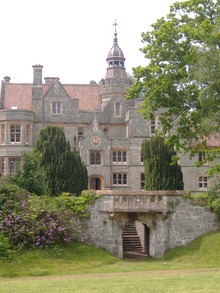
At

The Church of St Mary in
The Norman Church of St Giles in Thurloxton dates from the 14th century but is predominantly from the 15th century with 19th century restoration, including the addition of the north aisle in 1868. It has been designated by English Heritage as a grade II* listed building.[62] From October 1763 to January 1764 the vicar was the diarist James Woodforde.[6]
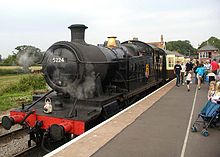
The West Somerset Railway (WSR) is a heritage railway that runs along the edge of the Quantock Hills between Bishops Lydeard and Watchet. The line then turns inland to Washford, and returns to the coast for the run to Minehead. At 23 miles (37 km), it is the longest privately owned passenger rail line in the UK.[63]
Halswell House in Goathurst has Tudor origins but was purchased by the Tynte family and rebuilt in 1689.[6] The surrounding park and 17 acres (6.9 ha) pleasure garden was developed between 1745 and 1785. The grounds contain many fish ponds, cascades, bridges and fanciful buildings,[67] including the Temple of Harmony, which stands in Mill Wood[68] and has now been fully restored.
See also
References
- ^ a b "Quantock Hills AONB Service Website". Quantock Hills AONB. Somerset County Council. Archived from the original on 7 February 2012. Retrieved 18 April 2011.
- ^ NCA 146: Vale of Taunton & Quantock Fringes Key Facts & Data at www.naturalengland.org.uk. Retrieved 4 October 2013
- ^ ISBN 0-906456-98-3.
- ^ a b c d "The Quantocks" (PDF). English Nature. Retrieved 24 January 2007.
- ^ ISBN 0-7028-8380-8.
- ^ ISBN 0-7091-1158-4.
- ISBN 9781456416317.
- ^ Baker, Laurie (February 2005). "Saturday 30 October 2004 Minehead, Watchet and Blue Ancho". Journal of the Open University Geological Society (London Branch). 12 (1). Archived from the original on 18 February 2007.
- ^ Historic England. "Oil retort house (1057429)". National Heritage List for England. Retrieved 7 October 2007.
- ^ Farr, Grahame (1954). Somerset Harbours. London: Christopher Johnson. p. 138.
- ^ Historic England. "Brick Kiln (1345620)". National Heritage List for England. Retrieved 27 January 2008.
- ^ "About south-west England". Met Office. Archived from the original on 25 February 2006. Retrieved 21 May 2006.
- ISBN 0-86183-028-8
- ^ "Ruborough Camp, Broomfield". Somerset Historic Environment Record. Retrieved 8 March 2008.
- ^ "Dowsborough hillfort, Holford". Somerset Historic Environment Record. Retrieved 8 March 2008.
- ^ "Analysis of Coin Hoards from Roman Britain". Historia. Retrieved 31 December 2011.
- ^ The Anglo-Saxon Chronicle, 676-99 AD
- The Victoria History of the County of Somerset, Vol. 1 (1906)
- ISBN 978-0-85115-369-8.
- ^ "Crowcombe by Clare Gathercole" (PDF). Somerset Urban Archaeological Survey. Archived from the original (PDF) on 25 October 2012. Retrieved 2 February 2010.
- ^ Farr, Grahame (1954). Somerset Harbours. London: Christopher Johnson. pp. 125–137.
- ^ Dumnonia and the Valley of the Parret, Rev. W.H.P. Greswell (1922)
- ISBN 978-1897689004.
- ^ "Nether Stowey Castle orientation leaflet" (PDF). Quantock Online. Retrieved 11 March 2008.
- ^ "Stowey Castle, Nether Stowey". Somerset Historic Environment Record. Retrieved 11 March 2008.
- ^ Historic England. "Remains of Keep to Stowey Castle (1059074)". National Heritage List for England. Retrieved 10 March 2008.
- ^ "Nether Stowey". Quantock Online. Retrieved 10 March 2008.
- ISBN 0-7153-5805-7.
- ^ a b Foard, Glen (28 July 2003). "Sedgemoor Batlle and Monmouth Rebellion Campaign". The UK Battlefields Resource Centre. Retrieved 11 April 2008.
- ^ "Buckingham Mine, Dodington, Bridgwater (Bridgewater), Somerset, England, UK". Minedat. Retrieved 10 March 2008.
- ^ Hamilton, John; Lawrence, J.F. (1970). Men and Mining on the Quantocks. Bracknell: Town & Country Press Ltd. pp. 28–77.
- ^ Historic England. "Remains of spire, in churchyard, 15 metres East of chancel, Church of the Holy Ghost (1345693)". National Heritage List for England. Retrieved 17 November 2007.
- ^ "Crowcombe". Everything Exmoor. Archived from the original on 11 December 2011. Retrieved 30 November 2011.
- ^ "History". Crowcombe. Archived from the original on 6 November 2007. Retrieved 17 November 2007.
- ^ "In the Footsteps of the Romantic Poet". The Coleridge Way. Retrieved 15 July 2007.
- ^ "Quantock Greenway". Walking pages. Archived from the original on 3 May 2007. Retrieved 16 November 2007.
- London Gazette. Retrieved 11-04-28
- ^ "Quantock Hills Joint Advisory Committee (JAC) Papers 2013 and 2014". Quantock Hills AONB. Retrieved 29 August 2014.
- ^ Keeble, Jim (15 September 2001). "UK: Somerset plays a Romantic lead". The Telegraph. Retrieved 5 August 2015.
- ^ "Walk The Coleridge Way". BBC Somerset. Retrieved 12 February 2008.
- ^ Historic England. "Alfoxton Park Hotel (1057418)". National Heritage List for England. Retrieved 9 March 2008.
- ^ Thomas, Edward. "In Pursuit of Spring". Internet Archive.
- ^ A P Baggs and M C Siraut, 'Aisholt', in A History of the County of Somerset: Volume 6, andersfield, Cannington, and North Petherton Hundreds (Bridgwater and Neighbouring Parishes), ed. R W Dunning and C R Elrington (London, 1992), pp. 68-69 http://www.british-history.ac.uk/vch/som/vol6/pp68-69 [accessed 17 May 2015].
- ^ Ridler, Anne. Memoir.
- ISBN 9780521484022.
- ^ le Carré. "John".
- ^ "Anne Ridler". Tim Whittingham. Retrieved 29 August 2014.
- ^ "Bryan Adams at The Silk Mills Holford - Holford Silk Mills Holford Somerset".
- ^ "Joy Division Oven Gloves". Music Match. Retrieved 2 October 2015.
- ^ "Shada". BBC. Retrieved 2 October 2015.
- ^ "Peep Show (UK)". Share TV. Retrieved 2 October 2015.
- ^ "Peep Show Quantocking". IMDb. Retrieved 2 October 2015.
- ^ "Coleridge Cottage". Friends of Coleridge. Archived from the original on 15 December 2007. Retrieved 16 November 2007.
- ^ Historic England. "No 35 (Coleridge's Cottage) and No 37 (1344921)". National Heritage List for England. Retrieved 16 November 2007.
- ^ "The Campaign to Acquire Coleridge Cottage". University of Alberta. Retrieved 16 November 2007.
- ^ Morris, Steven (9 September 2011). "Samuel Taylor Coleridge's cottage to reopen after revamp". The Guardian. Retrieved 6 February 2015.
- ^ Historic England. "St. Mary's church, Kingston St Mary (1176326)". National Heritage List for England. Retrieved 7 March 2008.
- ^ "Kingston St Mary". Quantock Online. Retrieved 7 March 2008.
- ^ "citation sheet for Hestercombe House" (PDF). English Nature. Retrieved 3 March 2007.
- ^ "Hestercombe House". Joint NatureConservation Committee. Retrieved 30 November 2011.
- ^ "The Army at Hestercombe Gardens". Hestercombe Gardens. Retrieved 30 November 2011.
- ^ Historic England. "Church of St Giles (1295089)". National Heritage List for England. Retrieved 30 October 2007.
- ^ "Point 1: West Somerset Railway". Coast. Retrieved 11 April 2008.
- ^ "History of the Manor". Halsway Manor. Archived from the original on 23 September 2009. Retrieved 5 December 2009.
- ^ "About Halsway Manor". Pictures of England. Retrieved 17 November 2007.
- ^ Historic England. "Halsway Manor (1057472)". National Heritage List for England. Retrieved 17 November 2007.
- ^ Historic England. "Ornamental bridge with flanking half-figures (1344984)". National Heritage List for England. Retrieved 4 November 2006.
- ^ Historic England. "Temple (1058952)". National Heritage List for England. Retrieved 4 November 2006.
External links
- Quantock Hills Area of Outstanding Natural Beauty official website

